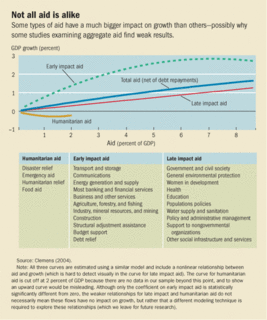Michael Clemens, Steven Radelet and Rikhil Bhavnani
Center for Global Development Working Paper # 44
07/22/2004
The authors consider about half of all donor assistance, specifically that portion that that they suggest is specifically intended to stimulate short term economic growth. This portion includes aid for: transportation and storage; communications; energy generation and supply; business and other services; agriculture, forestry and fishing; industry, mineral resources and mining; construction. Their analysis adds to these forms, aid to banking and financial services and aid that comes in the form of cash (e.g. structural ajustment assistance, budget support and debt relief).
Using a model that assumes diminishing returns to increased aid (as a portion of GDP), and analyzing four-year periods, the authors find that this form of aid tends to stimulate growth:

(Illustration from "Aid and Growth", F&D, September 2005.)
"Consider the mean observation, where early impact aid is 2.7 percent of GDP (roughly equivalent to where total aid is about 5.4 percent of GDP). Using our most conservative results, at the mean, a 1 percentage point of GDP increase in early impact aid produces an additional 0.31 percentage point of annual growth over the four-year period. With plausible assumptions about discount and depreciation rates (summing to 35 percent), we calculate that each $1 in early impact aid yields $1.64 in increased income in the recipient country in net present value terms. This country-level return roughly corresponds to a project-level rate of return of around 13 percent. For sub-Saharan Africa, we find that higher-than-average early impact aid raised per capita growth rates by about 1 percentage point over the growth that would have been achieved by average aid flows."
They acknowledge that even this aid works better in countries with strong institutions than in those without, but that even in countries with weak institutions the right kind of aid can pay off is the short term in growth. The authors recognize that humanitarian assistance and aid directed to long term goals such as improved health are also useful and important, but emphasize that these latter forms of aid should not be expected to show high economic growth impact in the short term.
This research is I think important in that aid has increasingly been going to the social sectors, while expectations for short term economic benefits have not been reduced.

Graph from "Picture This: Aiding Development", Finance and Development, September 2005, Volume 42, Number 3
No comments:
Post a Comment